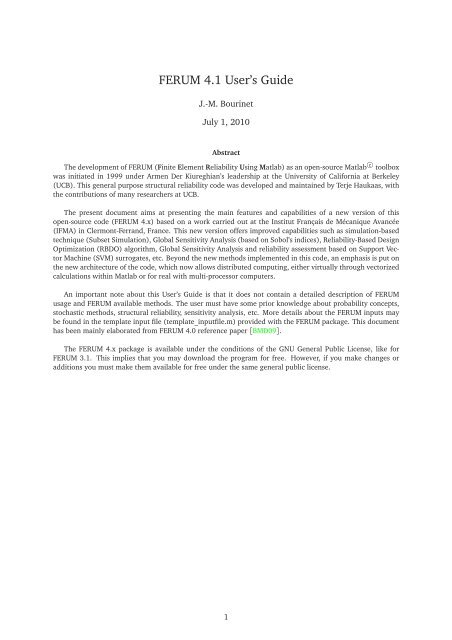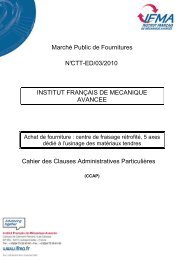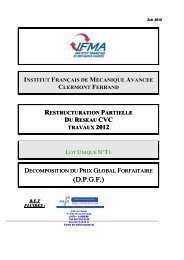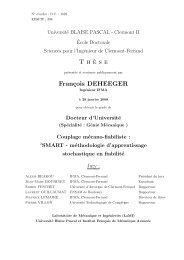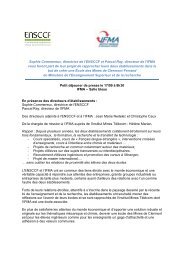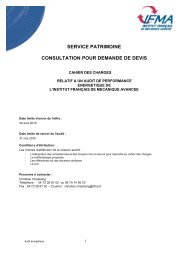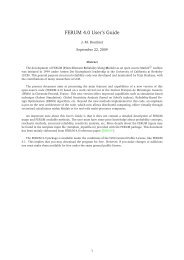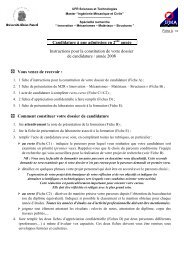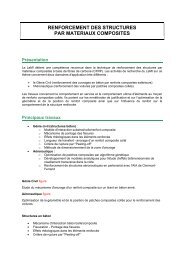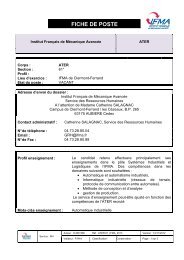FERUM 4.1 User's Guide - IFMA
FERUM 4.1 User's Guide - IFMA
FERUM 4.1 User's Guide - IFMA
Create successful ePaper yourself
Turn your PDF publications into a flip-book with our unique Google optimized e-Paper software.
<strong>FERUM</strong> <strong>4.1</strong> User’s <strong>Guide</strong>J.-M. BourinetJuly 1, 2010AbstractThe development of <strong>FERUM</strong> (Finite Element Reliability Using Matlab) as an open-source Matlab c○ toolboxwas initiated in 1999 under Armen Der Kiureghian’s leadership at the University of California at Berkeley(UCB). This general purpose structural reliability code was developed and maintained by Terje Haukaas, withthe contributions of many researchers at UCB.The present document aims at presenting the main features and capabilities of a new version of thisopen-source code (<strong>FERUM</strong> 4.x) based on a work carried out at the Institut Français de Mécanique Avancée(<strong>IFMA</strong>) in Clermont-Ferrand, France. This new version offers improved capabilities such as simulation-basedtechnique (Subset Simulation), Global Sensitivity Analysis (based on Sobol’s indices), Reliability-Based DesignOptimization (RBDO) algorithm, Global Sensitivity Analysis and reliability assessment based on Support VectorMachine (SVM) surrogates, etc. Beyond the new methods implemented in this code, an emphasis is put onthe new architecture of the code, which now allows distributed computing, either virtually through vectorizedcalculations within Matlab or for real with multi-processor computers.An important note about this User’s <strong>Guide</strong> is that it does not contain a detailed description of <strong>FERUM</strong>usage and <strong>FERUM</strong> available methods. The user must have some prior knowledge about probability concepts,stochastic methods, structural reliability, sensitivity analysis, etc. More details about the <strong>FERUM</strong> inputs maybe found in the template input file (template_inputfile.m) provided with the <strong>FERUM</strong> package. This documenthas been mainly elaborated from <strong>FERUM</strong> 4.0 reference paper[BMD09].The <strong>FERUM</strong> 4.x package is available under the conditions of the GNU General Public License, like for<strong>FERUM</strong> 3.1. This implies that you may download the program for free. However, if you make changes oradditions you must make them available for free under the same general public license.1
Contents1 Introduction 32 Problem definition and structure of <strong>FERUM</strong> 4.x 32.1 Time invariant structural reliability . . . . . . . . . . . . . . . . . . . . . . . . . . . . . . . . . . . . . . 32.2 Probability distributions and transformation to standard normal space . . . . . . . . . . . . . . . . 42.3 Definition of limit-state functions . . . . . . . . . . . . . . . . . . . . . . . . . . . . . . . . . . . . . . . 52.4 Vectorized/distributed computing . . . . . . . . . . . . . . . . . . . . . . . . . . . . . . . . . . . . . . 63 Overview of available methods 63.1 FORM and reliability sensitivities/importance measures . . . . . . . . . . . . . . . . . . . . . . . . 63.1.1 Basic FORM . . . . . . . . . . . . . . . . . . . . . . . . . . . . . . . . . . . . . . . . . . . . . . . . 63.1.2 Reliability sensitivities/importance measures . . . . . . . . . . . . . . . . . . . . . . . . . . . 73.1.3 FORM with search for multiple design points . . . . . . . . . . . . . . . . . . . . . . . . . . . 83.2 SORM curvature-fitting and point-fitting . . . . . . . . . . . . . . . . . . . . . . . . . . . . . . . . . . . 83.3 Distribution Analysis . . . . . . . . . . . . . . . . . . . . . . . . . . . . . . . . . . . . . . . . . . . . . . . 93.4 Crude Monte Carlo Simulation, Importance Sampling . . . . . . . . . . . . . . . . . . . . . . . . . . . 93.5 Directional Simulation . . . . . . . . . . . . . . . . . . . . . . . . . . . . . . . . . . . . . . . . . . . . . . 113.6 Subset Simulation . . . . . . . . . . . . . . . . . . . . . . . . . . . . . . . . . . . . . . . . . . . . . . . . . 123.7 2 SMART . . . . . . . . . . . . . . . . . . . . . . . . . . . . . . . . . . . . . . . . . . . . . . . . . . . . . . . 133.8 Global Sensitivity Analysis . . . . . . . . . . . . . . . . . . . . . . . . . . . . . . . . . . . . . . . . . . . . 143.9 Reliability-Based Design Optimization . . . . . . . . . . . . . . . . . . . . . . . . . . . . . . . . . . . . 163.10 Random fields . . . . . . . . . . . . . . . . . . . . . . . . . . . . . . . . . . . . . . . . . . . . . . . . . . . 174 Getting started 175 Organization of <strong>FERUM</strong> 4.x m-files 176 Release summary 192
1 Introduction<strong>FERUM</strong> (Finite Element Reliability Using Matlab) is a general purpose structural reliability code whose firstdevelopments started in 1999 at the University of Cafifornia at Berkeley (UCB)[DKHF06]. This code consistsof an open-source Matlab c○ toolbox, featuring various structural reliability methods. As opposed to commercialstructural reliability codes, see e.g.[PS06] for a review in 2006, the main objective of <strong>FERUM</strong> is to providestudents with a tool immediately comprehensible and easy to use and researchers with a tool very accessiblewhich they may develop for research purposes. The scripting language of Matlab is perfect for such objectives,as it allows users to give commands in a very flexible way, either in an interactive mode or in a batch modethrough input files.<strong>FERUM</strong> was created under Prof. Armen Der Kiureghian’s leadership and was managed by Terje Haukaas atUCB until 2003. It benefited from a prior experience with CalRel structural reliability code, which features allthe methods implemented in the last version of <strong>FERUM</strong>. It also benefited from the works of many researchersat UCB, who made valuable contributions in the latest available version (version 3.1), which can be downloadedat the following address: http://www.ce.berkeley.edu/<strong>FERUM</strong>/. Since 2003, this code is no longerofficially maintained.This document is a basic user’s manual of a new version of this code (<strong>FERUM</strong> 4.x), which results froma work carried out at the Institut Français de Mécanique Avancée (<strong>IFMA</strong>) in Clermont-Ferrand. As previouslyachieved in the past, the main intention is to provide students and researchers with a developer-friendly computationalplatform which facilitates learning methods and serves as a basis for collaborative research works.<strong>FERUM</strong> should still be viewed as a development platform for testing new methods and applying them tovarious challenging engineering problems, either represented by basic analytical models or more elaboratednumerical models, through proper user-defined interfaces.The main architecture of <strong>FERUM</strong> was preserved in general, see Section 2 for more details. In order toimprove its efficiency in terms of computational time, all algorithms have been revisited to extend <strong>FERUM</strong>capabilities to distributed computing. For example, in its new version, <strong>FERUM</strong> makes Monte Carlo Simulation(MCS) much faster thanks to limit-state functions defined in a vectorized form or real distributed computing,according that a proper interface is defined for sending multiple jobs to a multi-processor computer platform.2 Problem definition and structure of <strong>FERUM</strong> 4.xThis section briefly presents the general formulation of time-invariant structural reliability problems. In additionto some very brief details about theoretical concepts, this section highlights how these concepts aretranslated to <strong>FERUM</strong> structure. This includes for instance the stochastic model, the transformation to standardnormal variates, limit-state functions and more generally other points regarding computational aspects.It is important here to recall that the main structure of input data in <strong>FERUM</strong> is preserved compared to version3.1 (same Matlab structure variables: probdata, analysisopt, gfundata, femodel). Changes broughtto <strong>FERUM</strong> are applied to core m-functions and within the fields of the existing structure variables. Similarlyto version 3.1, results are stored in structure variables with the following syntax: results keyword appendedto the name of the method applied, such as e.g. formresults,sormcfhresults, etc.2.1 Time invariant structural reliabilityWe consider here only time invariant structural reliability problems, see e.g.[DM07, Lem09]. The probabilityw.r.t. an undesired or unsafe state is expressed in terms of a n-dimensional vector X of random variables withcontinuous joint density function f X (x,θ f ), whereθ f stands for a vector of distribution parameters. Failureis defined in terms of a limit-state function g(x,θ g ) where x is a realization of the random vector X andθ gdenotes a vector of deterministic limit-state function parameters. We restrict here the analysis to componentreliability with a single g function, but this function may represent multiple failure modes in subset simulationin Section 3.6, without lack of generality. This limit-state function divides the random variable space in a safetydomain, g(x,θ g )>0, and a failure domain, g(x,θ g )≤0. The probability of failure therefore reads:∫p f =g(x,θ g )≤0f X (x,θ f ) dx (1)3
2.2 Probability distributions and transformation to standard normal spaceThe joint density function f X (x,θ f ) is often unknown and replaced by its Nataf counterpart completelydefined by specifying marginal distributions and the Gaussian correlation structure between random variables,see[LDK86]. This Nataf joint distribution is completely specified by variables probdata.marg andprobdata.correlation in <strong>FERUM</strong> input files. <strong>FERUM</strong> has a rich library of probability distribution models,including extreme value distributions and a truncated normal distribution. These distributions can bespecified through either their statistical moments or parameters. See hereafter the corresponding part of theinputfile_template.m file.% Marginal distributions for each random variable% probdata.marg = [ (type) (mean) (stdv) (startpoint) (p1) (p2) (p3) (p4) (input_type); ... ];%% type: -1 = Parameter in reliability analysis (thetag)% 0 = Deterministic parameter (cg)%% 1 = Normal distribution% 2 = Lognormal distribution% 3 = Gamma distribution% 4 = Shifted exponential distribution% 5 = Shifted Rayleigh distribution% 6 = Uniform distribution% 7 = Beta distribution% 8 = Chi-square distribution%% 11 = Type I largest value distribution ( same as Gumbel distribution )% 12 = Type I smallest value distribution% 13 = Type II largest value distribution% 14 = Type III smallest value distribution% 15 = Gumbel distribution ( same as type I largest value distribution )% 16 = Weibull distribution ( same as Type III smallest value distribution with epsilon = 0 )%% 18 (Reserved for Laplace distribution)% 19 (Reserved for Pareto distribution)%% 51 = Truncated normal marginal distribution%% Notes:%% - Each field type, mean, stdv, startpoint, p1, p2, p3, p4, input_type must be filled in.% If not used, input a dummy nan value.%% - input_type = 0 when distributions are defined with mean and stdv only% 1 when distributions are defined with distribution parameters pi% (i = 1, 2, 3 or 4, depending on the total number of parameters required)%% - For the Type III smallest value marginal distribution, you must give the value of% epsilon parameter as p3 when using the mean and stdv input (input_type = 0).% - For the Beta marginal distribution , you must give the value of a parameter as p3 and% b parameter as p4 when using the mean and stdv input (input_type = 0).% - For the Truncated normal marginal distribution, you must set input_type = 1 and give :% * the mean and stdv of the untruncated marginal distribution as p1 and p2 respectively% * the lower bound xmin and the upper bound xmax as p3 and p4 respectively%% - startpoint stands for the starting point of the FORM analysis in the physical space%% - Refer to ferum_pdf.m, ferum_cdf.m and distribution_parameter.m functions for more information% on a specific distribution.% Correlation matrix% This matrix is a square matrix with dimension equal to size(probdata.marg,1).% Lines/columns corresponding to parameters in reliability analysis(thetag) or deterministic% parameters (cg) are removed in a pre-processing stage of <strong>FERUM</strong>, by means of the update_data.m% function.The structural reliability problem of Equation (1) expressed in the original space of physical random variablesX is transformed to a standard normal space where U becomes an independent standard normal vector.This mapping is carried out in <strong>FERUM</strong> using the Nataf model[LDK86]. Physical random variables X aretransformed to correlated standard normal variables Z whose correlation structure obeys integral relation ofEquation (3) and Z is then transformed to uncorrelated standard normal variables U.f Xi, i= 1,..., nX with R= → Z∼ N 0,Rρ 0 → U∼ N(0,I) (2)i jn×n4
For each i j-pair of variables with known correlationρ i j , Equation (3) should be solved to determinecorrelationρ 0 i j between mapped z-variables:ρ i j =∫ +∞ ∫ +∞−∞−∞ xi −µ i x j −µ jϕ 2 (z i ,z j ,ρ 0 i j ) dz i dz j (3)σ iwhereµ i andσ i respectively stand for the mean and standard deviation of the ith component of X, andϕ 2 (•,•,ρ) is the 2D standard normal probability density function (pdf) with correlation coefficientρ.Independent standard normal variables U are then obtained from Z variables such as follows:σ ju=L −10 z (4)where L 0 is the lower-triangular Cholesky decomposition of R 0 = ρ 0 i jmatrix, such that L0 L T 0 = R 0.Solutions of Equation (3) can be found by formulae of reference[LDK86] for most common statisticaldistributions. These formulae are most often obtained by least-square fitting and therefore approximate, exceptfor a few pairs of distributions. <strong>FERUM</strong> 4.x is now based on accurate solutions obtained by 2D numericalGauss integration of Equation (3). A particular attention is paid to strongly correlated random variables,where the number of integration points along each dimension in z i z j -space must be selected carefully, foraccurateρ 0 i j values. A practical rule adopted here consists in increasing these numbers of points with correlation,ranging from 32 points along each dimension for absolute values of correlation lower than 0.9 to 1024points for absolute values larger than 0.9995.2.3 Definition of limit-state functionsAs in <strong>FERUM</strong> 3.1, the limit-state function is defined through the structure variablegfundata of the input fileand called by the file named gfun.m. Various strategies are now offered in <strong>FERUM</strong> 4.x. The limit-state functioncan either be a simple expression directly written in the input file or a Matlab function. For both cases,gfun.m calls another function called gfunbasic.m. Another interesting option offered in <strong>FERUM</strong> 4.x is that thelimit-state function can be defined through a user-provided Matlab function, which calls a third-party software,such as a Finite Element code. Such merging of <strong>FERUM</strong> with problem-specific external codes was madein various applications, such as probabilistic buckling[DNBF09] and crack propagation[NBGL06]. For controllingsuch external codes, extra variables are provided to <strong>FERUM</strong> through the structure variable femodeland the user must create an application-specific function. One more option available in <strong>FERUM</strong> 4.x is that ittakes advantage of gradients w.r.t. all or parts of the basic variables, when available from the external code.This proves to be very useful when limit-state functions involve very computationally demanding numericalmodels, as it avoids tedious estimations by finite differences. <strong>FERUM</strong> 4.x is compatible with Code_Aster c○ ,running on a Windows OS. Code_Aster version STA9.1 compiled on Windows was developed by NECS and isavailable at http://www.necs.fr/gb/telechargement.php.See hereafter the corresponding part of the inputfile_template.m file.% Type of limit-state function evaluator:% ’basic’: the limit-state function is defined by means of an analytical expression or a Matlab% m-function, using gfundata(lsf).expression. The function gfun.m calls gfunbasic.m,% which evaluates gfundata(lsf).expression.% ’xxx’: the limit-state function evaluation requires a call to an external code. The function% gfun.m calls gfunxxx.m, which evaluates gfundata(lsf).expression where gext variable is% a result of the external code.Case of a limit-state function which is defined by means of an analytical expression or a Matlab m-function:gfundata(1).evaluator = ’basic’;gfundata(1).type = ’expression’; % Do no change this field!% Expression of the limit-state function:gfundata(1).expression = ’c1 - X2./(1000*X3) - (X1./(200*X3)).^2 - X5./(1000*X6) - (X4./(200*X6)).^2’;% Expression of the limit-state function:gfundata(1).expression = ’gfun_nl_oscillator(mp,ms,kp,ks,zetap,zetas,Fs,S0)’;Case of a limit-state function which requires a call to Code_Aster FE code:gfundata(1).evaluator = ’aster’;gfundata(1).type = ’expression’; % Do no change this field!% Expression of the limit-state function:gfundata(1).expression = ’gext-u0’;5
2.4 Vectorized/distributed computingA major change brought to <strong>FERUM</strong> 4.x is that calls to the limit-state function g can be evaluated in a distributivemanner, as opposed to the sequential manner of the previous version. Every algorithm implemented in<strong>FERUM</strong> was revisited, so as to send multiple calls to g, whenever possible. If one thinks of FE-based MonteCarlo Simulation (MCS) on a multiprocessor computer, the strategy consists in sending calls to the FE codein batches, the number of jobs in each batch being equal to the number of available CPUs. This strategy isknown as distributed computing, see e.g. examples of applications in[NBGL06, DNBF09]. The number of jobssent simultaneously is tuned through the variable analysisopt.block_size. Such an option is availablein <strong>FERUM</strong>, assuming that the user has a suitable computer platform and all the necessary tools to create, sendand post-process multiple jobs (scripting language such as Perl, queuing systems such as OpenPBS on Linux,job schedulers, . . . ). The function in charge of the job allocation is obviously application-specific and is calledby gfun.m.analysisopt.multi_proc = 1;% 1: block_size g-calls sent simultaneously% - gfunbasic.m is used and a vectorized version of% gfundata.expression is available.% The number of g-calls sent simultaneously (block_size) depends% on the memory available on the computer running <strong>FERUM</strong>.% - gfunxxx.m user-specific g-function is used and able to handle% block_size computations sent simultaneously, on a cluster% of PCs or any other multiprocessor computer platform.% 0: g-calls sent sequentiallyanalysisopt.block_size = 50; % Number of g-calls to be sent simultaneouslyBased on the same developments of <strong>FERUM</strong> algorithms, it is also possible to send multiple calls to a userdefinedMatlab limit-state function written in a vectorized manner. Vectorized calculations, in the Matlabsense, eliminate the need to cycle through nested loops and thus run much faster because of the way Matlabhandles vectors internally. The principle is similar to distributed computing, the difference being that themultiprocessor computer is virtually replaced by a single computer which can handle a number of runs simultaneously(this maximum number being directly dependent on the memory available on the computer). Hereagain, the maximum number of runs sent simultaneously is controlled throughanalysisopt.block_sizevariable.For illustration purpose, on an Intel T7800 2.6GHz dual core CPU with 4Gb RAM, a crude MCS takes31 min with 1.5·10 9 samples for a basic g=r− s problem, where R and S are normal random variables, in avectorized manner (<strong>FERUM</strong> 4.x), as opposed to 6 days 15 hours in a sequential manner.3 Overview of available methods3.1 FORM and reliability sensitivities/importance measures3.1.1 Basic FORMFirst-Order Reliability Method (FORM) (option 10 of <strong>FERUM</strong> 4.x) aims at using a first-order approximationof the limit-state function in the standard space at the so-called Most Probable Point (MPP) of failure P* (ordesign point), which is the limit-state surface closest point to the origin. Finding the coordinates u* of theMPP consists in solving the following constrained optimization problem:u*=arg min ‖u‖ g(x(u) ,θ g )= G u,θ g = 0Once the MPP P* is obtained, the Hasofer and Lind reliability indexβ is computed asβ=α T u* whereα=−∇ u G(u*)/ ∇u G(u*) is the negative normalized gradient vector at the MPP P*. It represents thedistance from the origin to the MPP in the standard space. The first-order approximation of the failureprobability is then given by p f 1 =Φ(−β), whereΦ(•) is the standard normal cdf. As in <strong>FERUM</strong> 3.1, thenew version is based on the iHLRF algorithm, see[ZDK94] for further details. In order to take advantage ofdistributed computing, g-calls required for gradient evaluations by finite differences at a specific point of thestandard space are sent in a single batch. The same technique is applied to step size evaluation with Armijorule, where all corresponding g-calls are sent simultaneously.(5)6
u 2( u)ϕ2= cstG ( u)1 ≤ 0*u 2Oβα *u 1P *u 1G ( u) = 0G ( u)T1 = β − α u = 0Figure 1: First-Order Reliability Method (FORM).Parameters specific to FORM in theanalysisopt.block_size structure variable are listed hereafter.% FORM analysis optionsanalysisopt.i_max = 100; % Maximum number of iterations allowed in the search algorithmanalysisopt.e1 = 0.001; % Tolerance on how close design point is to limit-state surfaceanalysisopt.e2 = 0.001; % Tolerance on how accurately the gradient points towards% the originanalysisopt.step_code = 0; % 0: step size by Armijo rule% otherwise: given value is the step sizeanalysisopt.Recorded_u = 1; % 0: u-vector not recorded at all iterations% 1: u-vector recorded at all iterationsanalysisopt.Recorded_x = 1; % 0: x-vector not recorded at all iterations% 1: x-vector recorded at all iterations% FORM, SORM analysis optionsanalysisopt.grad_flag = ’ddm’;% ’ddm’: direct differentiation% ’ffd’: forward finite differenceanalysisopt.ffdpara = 1000; % Parameter for computation of FFD estimates of gradients% Perturbation = stdv/analysisopt.ffdpara;% Recommended values: 1000 for basic limit-state functions,% 50 for FE-based limit-state functions3.1.2 Reliability sensitivities/importance measuresIn addition to the reliability indexβ and the MPP coordinates coming from a FORM analysis, the user mayuse <strong>FERUM</strong> 4.x to calculate the sensitivities ofβ (or of the failure probability p f ) to distribution parametersθ f or to deterministic limit-state function parametersθ g .For instance, the sensitivity ofβ w.r.t.θ f reads:where J u*,θfx*,θf=∂ ui /∂θ f j.∇ θfβ= J u*,θfx*,θf Tα (6)The Jacobian of the transformation is obtained by differentiating Equation (4) w.r.t.θ f parameters:∂ u= L −1 ∂ z0+ ∂ L−1 0z (7)∂θ f ∂θ f ∂θ fIn <strong>FERUM</strong> 4.x, sensitivities w.r.t. distributions parametersθ f are evaluated based on both terms of Equation(7), as opposed to <strong>FERUM</strong> 3.1 which only uses the first term. Sensitivities to correlation are based on thesecond term of this expression only, as the first one vanishes[BL08]. Sensitivities are evaluated numericallywith the same integration scheme as the one used for obtaining R 0 matrix and it is required to differentiate theCholesky decomposition algorithm in a step-by-step manner. Examples of application are given in reference[BL08].Parameters specific to FORM reliability sensitivities are listed hereafter. Thet are set up in the probdatastructure variable for sensitivities w.r.t. distributions parametersθ f and in the gfundata structure variablefor sensitivities w.r.t. deterministic limit-state function parametersθ g .7
% Flag for computation of sensitivities w.r.t. means, standard deviations, parameters and% correlation coefficients% 1: all sensitivities assessed, 0: no sensitivities assessmentprobdata.flag_sens = 1;% Flag for computation of sensitivities w.r.t. thetag parameters of the limit-state function% 1: all sensitivities assessed, 0: no sensitivities assessmentgfundata(1).flag_sens = 1;analysisopt.ffdpara_thetag = 1000; % Parameter for computation of FFD estimates of dbeta_dthetag% perturbation = thetag/analysisopt.ffdpara_thetag if thetag ~= 0% or 1/analysisopt.ffdpara_thetag if thetag == 0% Recommended values: 1000 for basic limit-state functions% 100 for FE-based limit-state functions3.1.3 FORM with search for multiple design pointsSearch for multiple MPPs such as described in[DKD98] is also implemented in <strong>FERUM</strong> 4.x (option 11). Figure2 illustrates the use of this method, applied to a 2D example with a parabolic limit-state function[DKD98]:g(x)= g(x 1 , x 2 )= b− x 2 −κ(x 1 − e) 2 (8)where b=5,κ=0.5 and e=0.1. Both variables x 1 and x 2 are independent and identically distributed (i.i.d.)standard normal random variables.This problem is characterized by two MPPs at similar distances from the origin and basic FORM algorithmresults are therefore not valid: 1.83·10 −3 instead of 3.02·10 −3 reference value for p f . Results in Figure2 are obtained with parameter values recommended in[DKD98], i.e.γ=1.1,δ=0.75 andε=0.5. Theseparameters are set in the form_multiple_dspts.m function. All valid MPP results obtained with <strong>FERUM</strong> 4.x arestored in anALLformresults array which is added as an extra field to theanalysisopt structure variable.5U-space5U-space5U-spacex20x20x20-5-5 0 5x1-5-5 0 5x1Figure 2: FORM with search for multiple design points.-5-5 0 5x13.2 SORM curvature-fitting and point-fittingAs in the previous version, <strong>FERUM</strong> 4.x offers two ways for computing a second-order approximation of thefailure probability. In both methods, the SORM approximation of the failure probability p f 2 is computed withBreitung or Tvedt formulae, as in <strong>FERUM</strong> 3.1.The first method consists in determining the principal curvatures and directions, by solving an eigenprobleminvolving the Hessian of the limit-state function (option 12 of <strong>FERUM</strong> 4.x). The Hessian is computedby finite differences, the perturbations being set in the standard normal space. All calls to the limit-state functioncorresponding to perturbated points are potentially sent simultaneously, as being all independent fromeach other.The second method consists in approximating the limit-state function by a piece-wise paraboloid surface[DKLH87](option 13 of <strong>FERUM</strong> 4.x). This approximate surface must be tangent to the limit-state atthe design point and coincides with the limit-state at two points on each axis selected on both sides of theorigin, see Figure 4. It is built iteratively, with a limited number of iterations and all calls to the limit-statefunction, at each iteration, are potentially sent simultaneously as well. This second approach is advantageousfor slightly-noisy limit-state functions (e.g. when a FE code is involved), for problem with a large number ofrandom variables or when the computation of curvatures turns out to be problematic.8
u 2 ( u)G =2 0( u)ϕ2= cstG ( u)2 ≤ 0*u 2Oβα *u 1P *u 1G ( u) = 0G ( u)T1 = β − α u = 0Figure 3: Second-Order Reliability Method (SORM).−−( v′ i, v′n)u′n−kβ( u) 0G′ ′ =β+ +( v′ i, v′n)kβu′iFigure 4: Second-Order Reliability Method - Point-fitting method (SORM-pf).3.3 Distribution Analysis<strong>FERUM</strong> 4.x offers a way to assess qualitatively (histograms) and quantitatively to some extent (only mean andvariance of the model outputs in the current version) the distribution of the limit-state function g (option 20of <strong>FERUM</strong> 4.x). This limit-state function may either return a scalar value ifgfundata(lsf).ng field is set to1 in the input file or a vector of values ifgfundata(lsf).ng is set to a value strictly greater than 1 (pleaserefer to the gfun.m function for more details).Parameters specific to a distribution analysis are listed hereafter.% Simulation analysis (MC,IS,DS,SS) and distribution analysis optionsanalysisopt.num_sim = 1e4; % Number of samplesanalysisopt.rand_generator = 1; % 0: default rand matlab function% 1: Mersenne Twister (to be preferred)% Simulation analysis (MC, IS) and distribution analysis optionsanalysisopt.sim_point= ’origin’; % ’dspt’: design point% ’origin’: origin in standard normal spaceanalysisopt.stdv_sim = 1; % Standard deviation of sampling distribution% in the simulation analysis3.4 Crude Monte Carlo Simulation, Importance SamplingEquation (1) is rewritten as follows:p f =∫D fXI(x) f X (x) dx= E fX[I(X)] (9)where D fXrepresents the integration domain of joint pdf f X (x), I(•) is an indicator function which equals 1 ifg(x)≤0 and 0 otherwise, and E fX[•] denotes the mathematical expectation w.r.t. joint pdf f X (x) (θ f andθ gparameters omitted for the sake of clarity).9
The expectation in Equation (9) is estimated in a statistical sense for a crude Monte Carlo Simulation(crude MCS). The u-space is randomly sampled with N independent samples u (j) , j= 1,..., N. These N samplesare then transformed to the x-space x (j) = x(u (j) ) and an unbiased estimate of p f is finally obtained fromthe sample mean of q j = I(x (j) ). Note that a standard deviation is also obtained for this sample, providinguseful information regarding the accuracy of the estimated value of p f .It must be stressed out here that a crude MCS requires a high computational effort (large N) for smallfailure probabilities and a number of variance reduction techniques have been proposed in the past to lowerthis computational effort. One of these variance reduction techniques is known as Importance Sampling (IS).Equation (9) is rewritten now in the following form:p f =∫I(x) f X(x)h(x) h(x) dx= E h I(X) f X(X)h(X)D hwhere h is called a sampling density. For an IS analysis, it is usual to take h(x)=h(x(u))=ϕ n (u−u*) whereϕ n is the n-dimensional standard normal pdf and u* is the vector of MPP coordinates coming from a previousFORM analysis. Note that p f is now obtained from the sample mean of q j = I(x (j) ) f X (x (j) )/h(x (j) ).(10)10X-space10X-space55s0s0-5-10 0 10 20r(a)-5-10 0 10 20r(b)55s0s0-5-5 0 5r(c)-5-5 0 5r(d)Figure 5: Crude Monte Carlo (CMC) vs. Importance Sampling (IS).<strong>FERUM</strong> 4.x features both methods and calls to the limit-state function are sent in a distributed manner, themaximum number of jobs sent being adjusted by the variableanalysisopt.block_size. For a crude MCSanalysis in <strong>FERUM</strong> 4.x, setanalysisopt.sim_point to’origin’ and select option 21. For an IS analysis,setanalysisopt.sim_point to’dspt’ and select option 21.Parameters specific to a crude MCS/IS analysis are listed hereafter.% Simulation analysis (MC,IS,DS,SS) and distribution analysis optionsanalysisopt.num_sim = 1e4; % Number of samplesanalysisopt.rand_generator = 1; % 0: default rand matlab function% 1: Mersenne Twister (to be preferred)% Simulation analysis (MC, IS) and distribution analysis optionsanalysisopt.sim_point= ’origin’; % ’dspt’: design point% ’origin’: origin in standard normal spaceanalysisopt.stdv_sim = 1; % Standard deviation of sampling distribution% in the simulation analysis10
% Simulation analysis (MC, IS)analysisopt.target_cov = 0.05; % Target coef. of variation for failure probabilityanalysisopt.lowRAM = 0; % 1: memory savings allowed% 0: no memory savings allowed3.5 Directional SimulationThe n-dimensional normal vector U is expressed as U=RA, R≥0, where R 2 is a chi-square distributedrandom variable with n degrees of freedom (d.o.f.), independent of the random unit vector A, which is uniformlydistributed on the n-dimensional unit sphereΩ n . The failure probability p f can be written as follows,conditioning on A=a[Bje88]:∫p f =where f A (a) is the uniform density of A on the unit sphere.a∈Ω n P[G(RA)≤0| A=a] f A (a) da (11)Practically, a sequence of N random direction vectors a (j) = u (j) / u(j) , j= 1,..., N, is generated first,then r j ={ r|G(ra (j) )=0} are found iteratively and p f is finally estimated from the following expression:p f = 1 NN∑j=1 1−χ 2 nr 2 j(12)whereχ 2 n is the chi-square cdf with n d.o.f.. u 21a(1)Oa2Ω(3)(2)auG ( u) = 0Figure 6: Directional Simulation (DS): Uniform distribution on the 2D unit sphereu 2r jO( j)a2Ωu 1G ( u) = 0Figure 7: Directional Simulation (DS): Determination of r j radiusIn <strong>FERUM</strong> 4.x, the user must select option 22 for a Directional Simulation (DS) analysis. Beside a classicalrandom generation of directions (analysisopt.dir_flag set to ’random’), a slightly modified versionof this algorithm is proposed. Instead of generating random directions on the unit sphere, it is proposed todivide it into N evenly distributed points, in a deterministic manner, in order to gain an improved accuracyat a given computational cost. This second option is selected by settinganalysisopt.dir_flag to’det’.In the two methods, intersections with the limit-state function along each direction are obtained in a distributivemanner, based on a vectorized version of fzero.m Matlab function. The maximum number of jobs sentis adjusted by the variable analysisopt.block_size. It is worth noting that DS looses efficiency as thenumber of random variables n increases.11
Parameters specific to a DS analysis are listed hereafter.% Simulation analysis (MC,IS,DS,SS) and distribution analysis optionsanalysisopt.num_sim = 200; % Number of directions (DS)analysisopt.rand_generator = 1; % 0: default rand matlab function% 1: Mersenne Twister (to be preferred)% Directional Simulation (DS) analysis optionsanalysisopt.dir_flag = ’det’; % ’det’: deterministic points uniformly distributed% on the unit hypersphere using eq_point_set.m% function% ’random’: random points uniformly distributed% on the unit hypersphereanalysisopt.rho = 8; % Max search radius in standard normal space for% Directional Simulation analysisanalysisopt.tolx = 1e-5; % Tolerance for searching zeros of g functionanalysisopt.keep_a = 0; % Flag for storage of a-values which gives axes% along which simulations are carried outanalysisopt.keep_r = 0; % Flag for storage of r-values for which g(r) = 03.6 Subset SimulationStarting from the premise that the failure event F={g(x,θ g )≤0} is a rare event, S.-K. Au and J.L. Beckproposed to estimate P(F) by means of more frequent intermediate conditional failure events F i , i= 1,..., m(called subsets) so that F 1 ⊃ F 2 ⊃ ...⊃ F m = F[AB01]. The m-sequence of intermediate conditional failureevents is selected so that F i ={g(x,θ g )≤ y i }, where y i ’s are decreasing values of the limit-state function andy m = 0. As a result, the failure probability p f = P(F) is expressed as a product of the following m conditionalprobabilities:m∏p f = P(F)= P(F m )= P(F m | F m−1 )P(F m−1 )=...= P(F 1 ) P(F i | F i−1 ) (13)i=25Unknownlimit−state5Unknownlimit−stateu 20u 20First threshold y 1−5−5 0 5u 1(a)First threshold y 1−5−5 0 5u 1(b)5Unknownlimit−state5Unknownlimit−stateu 20u 20Second threshold y 2Last threshold y =y =0 m 3−5 0 5−5−5 0 5−5u 1(c)u 1(d)Figure 8: Main steps in Subset Simulation.12
Each subset event F i (and the related threshold value y i ) is determined so that its corresponding conditionalprobability equals a sufficiently large valueα, in order to be efficiently estimated with a rather smallnumber of samples (in practiceα≈0.1-0.2, set byanalysisopt.pf_target parameter). In essence, thereis a trade-off between minimizing the number m of subsets by choosing rather small intermediate conditionalprobabilities and maximizing the same probabilities so that they can be estimated efficiently by simulations.The first threshold y 1 is obtained by a crude MCS, so that P(F 1 )≈α (see Figure 8, subplot (a)). For furtherthresholds, new sampling points corresponding to{ F i | F i−1 } conditional events are obtained from MarkovChains Monte Carlo (MCMC), based on a modified Metropolis-Hastings algorithm, see green star points infigure 8, subplot (b) corresponding to i= 2 case. The process is repeated until a negative threshold y i isfound. This is therefore the last step (i=m) and y m is set to 0. The corresponding probability P(F m | F m−1 )is then evaluated. See Figure 8, subplot (d). The last step is reached for m= i= 3 in the present case. Thecoefficient of variation of the failure probability estimated from SS can be evaluated by intermediate coefficientsof variation, weighted by the correlation that exists between the samples used for the estimation ofintermediate conditional probabilities, please refer to reference[AB01] for more details.For a Subset Simulation analysis, select option 23 in <strong>FERUM</strong> 4.x. Parameters specific to this methodare listed hereafter.% Simulation analysis (MC,IS,DS,SS) and distribution analysis optionsanalysisopt.num_sim = 10000; % Number of samples per subset step (SS)analysisopt.rand_generator = 1; % 0: default rand matlab function% 1: Mersenne Twister (to be preferred)% Subset Simulation (SS) analysis optionsanalysisopt.width = 2; % Width of the proposal uniform pdfsanalysisopt.pf_target = 0.1; % Target probability for each subset stepanalysisopt.flag_cov_pf_bounds = 1; % 1: calculate upper and lower bounds of the% coefficient of variation of pfanalysisopt.ss_restart_from_step = -inf;% 0: no calculation% i>=0 : restart from step i% -inf : all steps, no record (default)% -1 : all steps, record allanalysisopt.flag_plot = 0; % 1: plots at each step (2 r.v. examples only)% 0: no plotsanalysisopt.flag_plot_gen = 0; % 1: intermediate plots for each MCMC chain% (2 r.v. examples only)% 0: no plots3.7 2 SMARTBasic random variables realizations are classified in two classes, either they fall in the safety domain or in thefailure domain. The 2 SMART method hinges on the use of Support Vector Machines (SVMs)[Vap95, STC00,SS02] for classifying training points (called also learning points). The limit-state g(x)=0 must be seen hereas the perfect classifier. We assume that such a classifier exists, whatever the complexity of its geometry.The 2 SMART method starts from the pionneering idea of J.E. Hurtado’s work, who first introduced SVMs toreliability analysis[Hur04]. The key idea of 2 SMART is to build a SVM classifier for each Subset Simulationlikey i -threshold intermediate limit-state, which turns out to be more easy to manage than tackling g(x)=0directly. This learning process takes place in the standard space. The surrogate to each intermediate limit-stateg(x)− y i = 0 is constructed by training on a set of initial learning points and a few new points added in aniterative manner (concept of active learning[Mac92]).Table 1 gives an overview of the 2 SMART algorithm. More details about this method are available in a papersubmitted to Structural Safety[BDL10].1. An initial set of(N u + N n ) samples is used for the training of a first SVM-y i classifier (Table 1, part 1),notedg yi(x(u))= g(x(u))− y i , as an approximation to the exact intermediate limit-state g yi(x(u))=g(x(u))− y i = 0. Some of these samples (N n samples) are used for determining a suitable threshold valuey i corresponding to a target probability expected to be close toα=0.1, similarly to Subset Simulation.2. The strategy then consists in improving the initial SVM-y i classifier, by adding new points to the learningdatabase in an iterative manner (Table 1, part 2). These updates of the current SVM-y i classifier hingeon a coarse to fine adjustment strategy (localization, stabilization and convergence stages, see Figure9). The number of new points added at each iteration is increased with the number of random variablesn. By a wise selection of the “most informative” new training samples, drastic improvements of theaccuracy of the SVM classifier are obtained, with a rather limited amount of new samples.13
3. After a few iterations noted N iter max , the SVM-y i classifier is expected to become accurate enough andwe can evaluate P(˜F 1 ) corresponding to y 1 -threshold value at the first step of the algorithm (i= 1) orP(˜F i | ˜F i−1 ) corresponding to y i -threshold value at next steps (i> 1) (Table 1, part 3). For i= 1,..., m,˜F i stands for the SVM approximation of F i exact intermediate failure domain. For all steps except thelast, it is required to keep points which satisfyg yi(x(u))≤0(g-values lower or equal than y i basedon the current SVM-y i classifier) and which correspond to various numbers of points involved at eachstage (N 1 , N 2 , N 3 for localization, stabilization and convergence stages respectively). These points calledgerms serve for generating the sampling population of the next step.4. The P f estimate is given by the following expression: P f = P(˜F 1 ) ∏ mi=2 P(˜F i | ˜F i−1 ).Table 1: General flowchart of the 2 SMART algorithm.i= 0 , y 0 =+∞while y i > 0[Loop on each intermediate threshold value y i ]i=i+ 11. First set of training points→ y i -threshold. if y i < 0, set y i = 0→ Initial training of SVM-y i classifierfor k=1 to N iter max [ Update of the SVM classifier at each iteration k]2. Coarse to fine adjustment strategy for work populations: (1) Localization-L,(2) Stabilization-S, (3) Convergence-C (see Figure 9)→ New points added to the learning database→ New training of SVM-y i classifierend for k3. Evaluation of P(˜F 1 ) for i= 1 or P(˜F i | ˜F i−1 ) for i> 1Storage of≈αN 1 ,≈αN 2 and≈αN 3 points (called germs) for further applicationsofλr j or r j -mM algorithm if y i > 0end whilem= i4. Evaluation of P f estimate: P f = P(˜F 1 ) ∏ mi=2 P(˜F i | ˜F i−1 )For a 2 SMART simulation, select option 33 in <strong>FERUM</strong> 4.x. Parameters specific to this method are listedhereafter.analysisopt.num_sim_sdu = [ 50 50 ]; % Nu number of points%( [ first subset-like step, next steps], same values by default )analysisopt.num_sim_norm = [ 100 100 ]; % Nn number of points%( [ first subset-like step, next steps], same values by default )analysisopt.svm_buf_size = 3500^2;analysisopt.flag_var_rbf = 0;% RAM-size dependent parameter for eval_svm.m function% 0: cross validation at the 1st subset-like step only% 1: cross validation at all steps3.8 Global Sensitivity AnalysisGlobal Sensitivity Analysis aims at quantifying the impact of the variability in each (or group of) input variateson the variability of the output of a model in apportioning the output model variance to the variance in theinput variates. Sobol’ indices[Sob07] are the most usual global sensitivity measures. They can be assessed in<strong>FERUM</strong> 4.x.We consider here a model given by:Y= g(X)= g X 1 , X 2 ,..., X nwhere X=(X 1 , X 2 ,..., X n ) is a vector of n independent random input variates, g is a deterministic model andY is a scalar random output.In order to determine the importance of each input variate, we consider how the variance of the output Ydecreases when variate X i is fixed to a given x i * value:(14)14
% Global Sensitivity Analysis (GSA)- SVR optionsanalysisopt.SVRbasis = ’CVT_unif’; % SVRbasis =% ’Sobol_norm’: Points are deterministically generated% in the standard space (normal distribution)% (use of Sobol’ sequences in [0 1] hypercube)% ’CVT_unif’ : Points are deterministically generated% in an hypersphere with a specific radius% (use of Voronoi cells)analysisopt.SVR_Nbasis = 200; % Number of points in the design of experimentsanalysisopt.gridsel_option = 1; % SVR parameter for cross validation search (do not modify)% Parameters C, epsilon and sigma (RBF kernel is chosen) are determined in the train_SVR.m function.% However, the user may have some knowledge of the problem in order to define a grid search% for the hyperparameters (C, epsilon, sigma)analysisopt.n_reg_radius = 200000; % Number of samples for assessing the radius of the% learning hypersphere, when analysisopt.SVRbasis = ’CVT_unif’analysisopt.svm_buf_size = 3500^2; % RAM-size dependent parameter for eval_svm.m function3.9 Reliability-Based Design Optimization<strong>FERUM</strong> 4.x now offers Reliability-Based Design Optimization (RBDO) capabilities. The problem of interestreads, in its most basic and general formulation:min c(θ) s.t.f 1 (θ) ,..., f q−1 (θ)≤0θ(20)f q (x,θ)=β t −β(x,θ)≤0where:• θ stands for the design variables of the problem, either purely deterministic variablesθ g or distributionparametersθ f ,• c(θ) is the cost function to be minimized,• f 1 (θ),..., f q−1 (θ) is a vector of(q− 1) deterministic constraints over the design variablesθ,• f q (x,θ) is the reliability constraint enforcing the respect of the design rule referred to as the limit-statefunction and considering the uncertainty to which some of the model parameters x are subjected to.β tis the targeted safety index.One way to answer the problem in Equation (20) consists in a brute-force outer optimization loop over thereliability evaluation, here termed “Nested bi-level approach” (N2LA). This might be computational expensivein the case of simulation-based methods such as MCS and DS, as addressed in[RP04] and[RP07] respectively.However, if based on FORM, this brute-force method gives a solution within a reasonable amount ofcalls to the limit-state function. The outer optimization loop makes use of the Polak-He optimization algorithm[Pol97]and requires the gradients of both cost and constraints functions, which themselves require thegradient of the reliability indexβ w.r.t. design variablesθ.Previous RBDO applications of the Polak-He algorithm showed that its rate of convergence was highlydependent on the order of magnitude of the design parameters, cost and constraints functions. In <strong>FERUM</strong> 4.x,all these values are normalized at each Polak-He iteration, thus improving and ensuring convergence, whateverthe initial scaling of the problem in Equation (20). Convergence to an optimum is assumed to be obtainedwhen the cost function has reached a stable value and all the constraints are satisfied, i.e. f 1 (θ),..., f q (θ)≤0.In order to carry out a N2LA FORM-based RBDO analysis, select option 40 in <strong>FERUM</strong> 4.x. The currentimplementation is so far restricted to deterministic parameters as design parameters, i.e. θ=θ g . The costfunction (rbdo_fundata.cost field) is expressed in the form c(θ)=c 0 + c f p f , where p f represents thefailure probability. Deterministic constraints are defined by means of therbdo_fundata.constraint field.Parameters specific to the RBDO analysis are listed hereafter.% Cost function in the form:% c_0 + c_f * p_frbdo_fundata.cost = { ’4/3.*pi.*(r1.^3 - r0.^3)’ % c_0 term’0e2 * 4/3.*pi.*(r1.^3 - r0.^3)’ }; % c_f termrbdo_fundata.constraint = { ’- r0 + 40’% Deterministic constraints:’r1 - 150’ % fi
do_parameters.alpha = 0.5; % ph_quadprog parameterrbdo_parameters.beta = 0.6; % ph_quadprog parameterrbdo_parameters.gamma = 3; % ph_quadprog parameterrbdo_parameters.delta = 1; % ph_quadprog parameterrbdo_parameters.steplim = 50; % Max number of steps in stepsize calculation% (see ph_quadprog.m)rbdo_parameters.max_iter = 7; % Max number of iterations of N2LA algorithmrbdo_parameters.target_beta = 5; % Target beta reliability indexrbdo_parameters.method = ’FORM’;3.10 Random fields(nothing available yet)4 Getting startedYou might want to check out how <strong>FERUM</strong> works by running one of the examples provided with the programpackage. To do so, proceed as follows:1. Go to the <strong>FERUM</strong> 4.x homepage http://www.ifma.fr/<strong>FERUM</strong>/.2. Download the <strong>FERUM</strong>4.0.zip archive file and extract all compressed files to a directory of your choiceon your harddisk where you wish to save all <strong>FERUM</strong> files (extraction with pathnames).3. Before you can start using the toolbox, you must to add all <strong>FERUM</strong> subdirectories (aster_files, dir_simulations,etc.) to your Search Path, so that Matlab knows where to look for them. This is done by usingone of the three following options:• select “Set Path” in the “File” menu in Matlab,• select subdirectories in the Current Directory Browser, then right click, “Add to path”, “Selectedfolder and Subfolders”,• use the addpath.m function.4. Read one of the example inputfiles into your Matlab workspace. This can be done by issuing the command>> inputfile_xxx in Matlab. You now have the necessary input parameters for a reliabilityanalysis in your current Matlab workspace.5. Issue the command>> ferum in the Matlab workspace.6. Choose a specific option (e.g. option10 for a FORM analysis).7. The program now performs an analysis corresponding to the selected option and gives you intermediateresults/information as it runs.8. If the analysis is successful, you will finally see an overview of the available result parameters on thescreen. These results are gathered in the fields of a specific structure in the Matlab workspace (e.g.formresults if a FORM analysis is run).5 Organization of <strong>FERUM</strong> 4.x m-filesMain directory:• ferum.m main file• definition of distributions• <strong>FERUM</strong> pre-processing files (update_data.m, distribution_parameter.m)• Nataf model specific files including mod_corr_solve.m main file (files necessary for FORM sensitivitiesin the sensitivities directory)• Mapping from physical space to standard space (and reverse)• Limit-state function main file (gfun.m) and gfunbasic.minputfile directory:• Examples of inputfiles• Input file template (inputfile_template.m)17
gfunction directory• Examples of limit-state functions defined through Matlab .m filesFORM directory• Search for a single design point with the iHL-RF algorithm (form.m)• Search for possible multiple design points (form_multiple_dspts.m, via calls to form.m)• Auxiliary filessensitivities directory• All files necessary to assess FORM sensitivities w.r.t. distribution parametersθ f (means, standard deviations,correlation, distribution parameters) and deterministic parametersθ g in the limit-state functionSORM directory• SORM curvature-fitting method (sorm_cfh.m)• SORM point-fitting method (sorm_pf.m)• Auxiliary filesdistributions directory• Distribution of the limit-state function based on a Monte Carlo simulation (distribution_analysis.m)simulations directory• Crude Monte Carlo (CMC) simulation or Importance Sampling (IS) (simulation_single_dspt.m, simulation_single_dspt_lowRAM.m)• Mersenne Twister pseudo-random number generator (C++ source files twister.cpp-32bit and twister.cpp-64bit respectively for 32-bit and 64-bit computational platforms, Windows .dll file, Linux 32-bit .mexglxfile)dir_simulations directory• Directional Simulation (dir_simulation.m) with either random or deterministic directions (through callsto eq_point_set.m function and auxiliary files in eq_sphere_partitions directory)subset_simulations directory• Subset Simulation (subset_simulation.m)• Auxiliary files2SMART directory• 2 SMART simulation (ssvm_simulation.m)• Auxiliary files• kmeans files for clustering (kmeans subdirectory)Sobol directory• Global Sensitivity Analysis based on Sobol’ indices (Sobol_SA.m), either through calls to the originallimit-state function or to a SVR surrogate (Support Vector Regression).• Sobol’ quasirandom sequences generated by means of the Matlab Statistical Toolbox or the sobolseq51Windows .dll file from BRODA (BRODA subdirectory)• Training samples possibly re-arranged by means of Centroidal Voronoi Tessellation (CVT subdirectory)N2LA directory• Nested bi-level RBDO analysis based on FORM and gradient ofβ index w.r.t. design variables (N2LA.m)• Polak-He optimization algorithm (ph_quadprog.m)• fun.m auxiliary fileSVM directory• Spider toolbox (spider subdirectory)18
• SVM auxiliary files (svm_init.m and svr_init.m: initialization for classification and regression respectively,train_SVR.m: training of a SVR surrogate, eval_svm.m: evaluation based on a SVM surrogate,used both for classification and regression, gfunsvr.m: SVR surrogate function)ferum_in_loop directory• Example script files showing how to call <strong>FERUM</strong> in a silent modeaster_files directory• Files required for external calls to Code_aster Finite Element code in a sequential way (inputfile, gfunaster.mfunction called by gfun.m, Windows specific files, Code_aster template files, gawk binary, gawkfile for post processing of FE results)6 Release summary<strong>FERUM</strong> <strong>4.1</strong> (July 1, 2010) vs. 4.0 (September 9, 2009):• A new method is offered to assess small failure probabilities, based on Support Vector Machine (SVM)surrogates. This method referred as 2 SMART consists in essence to build a SVM classifier for each SubsetSimulation-like y i -threshold intermediate limit-state.• Global Sensitivity Analysis based on Sobol’ indices now works with models characterized by a vectorialoutput. The limit-state function may either return a scalar value if gfundata(lsf).ng field is setto 1 in the input file (default value) or a vector of values if gfundata(lsf).ng is set to a valuestrictly greater than 1. The Global Sensitivity Analysis works either with the physical model itself or SVRsurrogates. If the limit-state function has a vectorial output, a SVR surrogate is built for each componentof this vectorial output.• FORM with search for multiple design points can now be run in silent mode (analysisopt.echo_flagset to 0).• All SVM m-functions are gathered in the svm subdirectory (including the Spider toolbox). They may beuseful either in a 2 SMART analysis or in a SVR-based Global Sensitivity analysis.• A slightly modified version of twister.cpp file is given for 64-bit computational platforms. It preventscrashes which occur when the internal state of the generator needs to be saved by issuing the command>> S = twister(’state’).References[AB01] S.-K. Au and J.L. Beck. Estimation of small failure probabilities in high dimensions by subsetsimulation. Probabilistic Engineering Mechanics, 16:263–277, 2001.[BDL10] J.-M. Bourinet, F. Deheeger, and M. Lemaire. Assessing small failure probabilities by combinedsubset simulation and support vector machines. Submitted to Structural Safety, 2010.[Bje88] P. Bjerager. Probability integration by directional simulation. Journal of Engineering Mechanics,114(8):1285–1302, 1988.[BL08] J.-M. Bourinet and M. Lemaire. FORM sensitivities to correlation: Application to fatigue crackpropagation based on Virkler data. In Proc. of the 4th International ASRANet Colloquium, Athens,Greece, 2008.[BMD09] J.-M. Bourinet, C. Mattrand, and V. Dubourg. A review of recent features and improvements addedto <strong>FERUM</strong> software. In Proc. of the 10th International Conference on Structural Safety and Reliability(ICOSSAR’09), Osaka, Japan, 2009.[DKD98] A. Der Kiureghian and T. Dakessian. Multiple design points in first and second-order reliability.Structural Safety, 20(1):37–49, 1998.[DKHF06] A. Der Kiureghian, T. Haukaas, and K. Fujimura. Structural reliability software at the Universityof California, Berkeley. Structural Safety, 28(1-2):44–67, 2006.[DKLH87] A. Der Kiureghian, H.-Z. Lin, and S.-J. Hwang. Second-order reliability approximations. Journalof Engineering Mechanics, 113(8):1208–1225, 1987.19
[DM07] O. Ditlevsen and H.O. Madsen. Structural reliability methods. Internet Edition 2.3.7, 2007.[DNBF09] V. Dubourg, C. Noirfalise, J.-M. Bourinet, and M. Fogli. FE-based reliability analysis of the bucklingof shells with random shape, material and thickness imperfections. In Proc. of the 10th InternationalConference on Structural Safety and Reliability (ICOSSAR’09), Osaka, Japan, 2009.[Hur04] J.E. Hurtado. Structural reliability, statistical learning perspectives. Lecture Notes in Applied andComputational Mechanics Vol. 17, Springer, 2004.[LDK86] P.-L. Liu and A. Der Kiureghian. Multivariate distribution models with prescribed marginals andcovariance. Probabilistic Engineering Mechanics, 1(2):105–112, 1986.[Lem09] M. Lemaire. Structural reliability. John Wiley, 2009.[Mac92] D. MacKay. Information-based objective functions for active data selection. Neural Computation,4(4):590–604, 1992.[NBGL06] L. Nespurek, J.-M. Bourinet, A. Gravouil, and M. Lemaire. Some approaches to improve thecomputational efficiency of the reliability analysis of complex crack propagation problems. InProc. of the 3rd International ASRANet Colloquium, Glasgow, UK, 2006.[Pol97] E. Polak. Optimization: Algorithms and consistent approximations. Springer-Verlag, 1997.[PS06] M.F. Pellissetti and G.I. Schuëller. On general purpose software in structural reliability - anoverview. Structural Safety, 28:3–16, 2006.[RP04] J.O. Royset and E. Polak. Reliability-based optimal design using sample average approximations.Probabilistic Engineering Mechanics, 19(4):331–343, 2004.[RP07] J.O. Royset and E. Polak. Extensions of stochastic optimization results to problems with systemfailure probability functions. Journal of Optimization Theory and its Application, 132(2):1–18,2007.[Sob07] I.M. Sobol’. Sensitivity estimates for nonlinear mathematical models. Mathematical Modelling andComputational Experiments, 1:407–414, 2007.[SS02] B. Schölkopf and A. Smola. Learning with kernels. MIT Press, 2002.[STC00] J. Shawe-Taylor and N. Cristianni. An introduction to support vector machines and other kernelbasedlearning methods. Cambridge University Press, 2000.[Vap95] V. Vapnik. The nature of statistical learning theory. Springer, 1995.[ZDK94] Y. Zhang and A. Der Kiureghian. Two improved algorithms for reliability analysis. In R. Rackwitz,G. Augusti, and A. Borri, editors, 6th IFIP WG 7.5 Working Conference on Reliability and Optimisationof Structural Systems, Reliability and Optimization of Structural Systems. Chapman & Hall,1994.20
Subset Simulation-like stepi= 1 i> 1(L1)(L)Uniform work population λ 1 r j -mM work populationLocalization stage (L)N 1 sampling pointsIteration 1≤ k


